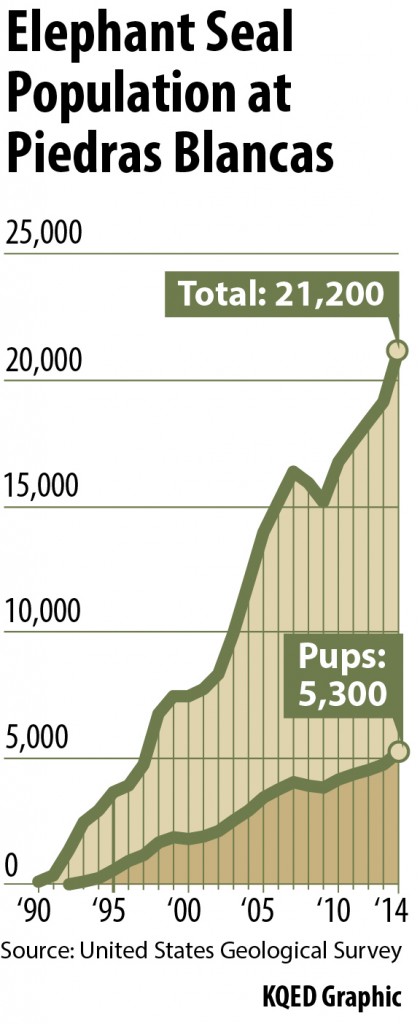Male elephant seals are the size of an SUV — fifteen feet long and 4,000 pounds. They’re known for their proboscis, the huge, fleshy nose that hangs over their mouth. There are plenty of available females this time of year, but most males will strike out. The dating scene is controlled by alpha males.
“The alpha strategy is to be dominant over a group of females, the harem,” says Wolfklain. “And they want to have the first right to mate.”
You can spot the alpha males right in the middle of their groups of 10 to 100 females. The other males, known as betas, are on the outskirts, just watching, waiting for their chance.
“So this guy’s coming in,” says Wolfklain, pointing at one beta male moving quickly toward a female. The alpha male perks up and snorts a warning with customary bravado. Sometimes the fight ends there, but not this one.
“Ooh, now they’re hitting with their heads,” the commentary continues, as the two lunge at each others’ chests. A few strikes seem to be enough for the beta male and he retreats.
These fights can be bloody and all the while, other males are taking advantage and sneaking in. It adds up to a very stressful time for male elephant seals.
It’s All About Reputation
“It’s not advantageous for males to fight all the time,” says Caroline Casey, a researcher at UC Santa Cruz. She says fights can be risky. “Sometimes they can result in death and we’ve seen that,” she says.
Elephant seals also don’t eat while on land, so they need to conserve energy. Casey says, as with humans, one way to avoid fighting is communication. But until now, no one was really sure what the males were saying to each other. So, she and her colleagues have been studying a patch of beach with about 50 males.
 “We have come up with this ranking system where we assign each male a score,” she says. It’s similar to systems used in professional sports, where the males win or lose points with every fight. Casey and her team also recorded the males’ calls and found remarkable differences.
“We have come up with this ranking system where we assign each male a score,” she says. It’s similar to systems used in professional sports, where the males win or lose points with every fight. Casey and her team also recorded the males’ calls and found remarkable differences.
One beta male, X579, has a call that ends in a flourish. “His call, to me, is my favorite,” she says. “He always has this really lovely note at the end of it.”
X579 was a beta male with a lot of competition. “He tends to vocalize and challenge everybody right when he gets there,” Casey says. He challenged GL, an alpha male with a very short, staccato call.
“That is what’s so incredible,” Casey says. “All of the animals sound completely different from one another.” What’s more, Casey’s team found that each male seems to use the same call year after year, whether he has a harem or not. It’s their signature call – and they flaunt it.
“A larger, more dominant animal will come up to a smaller animal, maybe beat him up a little bit,” says Casey, “call at him before and after, like, ‘Hey, this is me. I’m Bob. Don’t mess with me.'”
It’s all about spreading your reputation around. “That’s called associative learning and that’s very unique among marine mammals,” Casey explains. “That means that every male has the potential to be learning every other male based on their acoustic signature at that site.”
These complex communication systems have been studied in songbirds and other animals, but Casey says less is known about marine species. “I think it’s just a piece of larger puzzle in understanding how these animals breed and how they’re going to survive.”
A century ago, elephant seals were hunted to near extinction for their blubber. Fewer than 100 lingered off the coast of Mexico. With protective laws in place, today there are more than 150,000 northern elephant seals — and growing.
That’s good news for Casey’s loner elephant seal X579. This year, he’s an alpha male for the first time. As for the others, there’s always next year.


